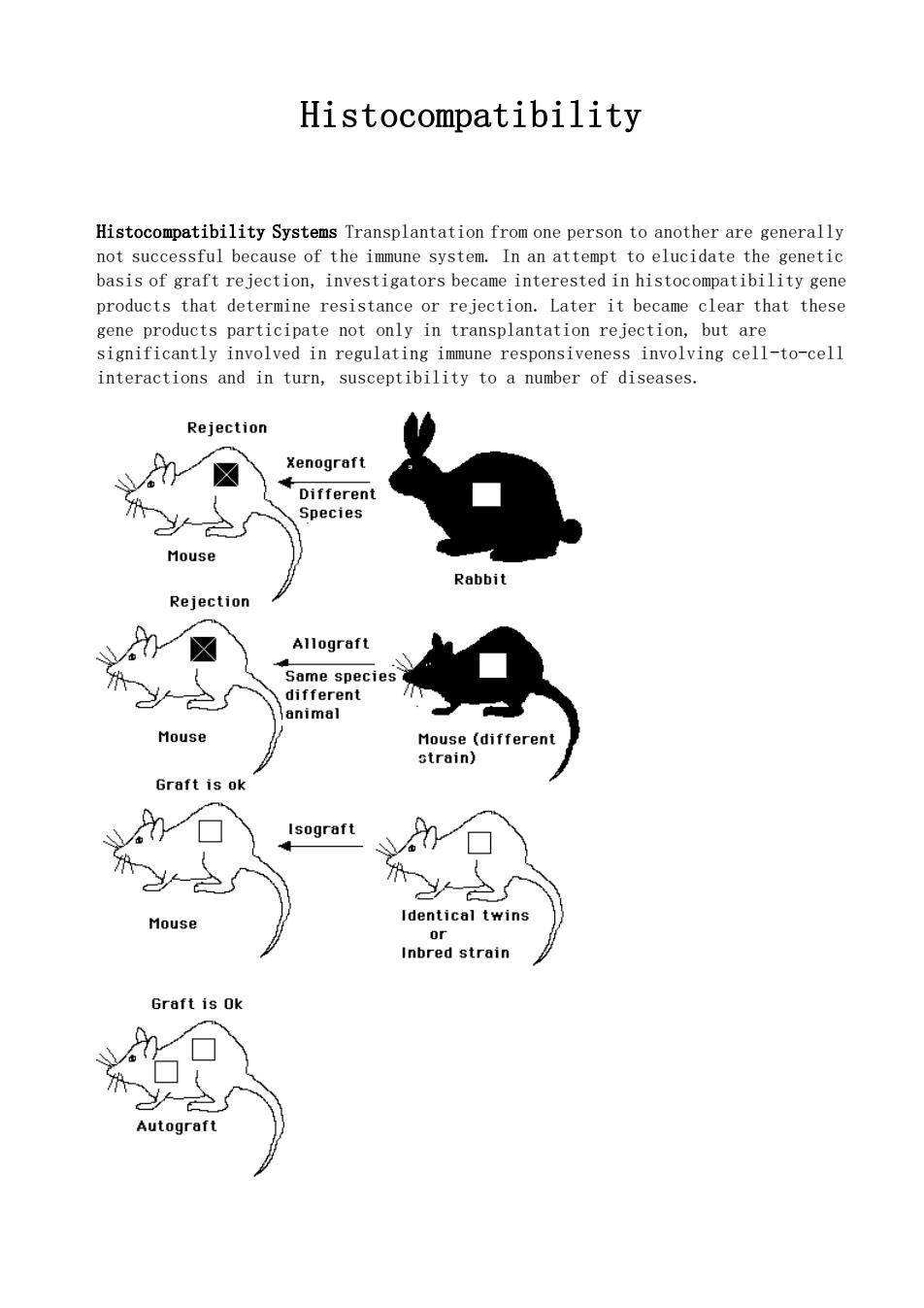
Histocompatibility Histocompatibility Systems Transplantation from one person to another are generally not successful because of the immune system.In an attempt to elucidate the genetic basis of graft rejection,investigators became interested in histocompatibility gene products that determine resistance or rejection.Later it became clear that these gene products participate not only in transplantation rejection,but are significantly involved in regulating immune responsiveness involving cell-to-cell interactions and in turn,susceptibility to a number of diseases. Rejection ☒ Xenogroft ifferent Species Mouse Rabbit Rejection ☒ Allograft Some species Mouse Graft is oh Isograft y人 Identical twins Inbred strain Graft is Ok
Histocompatibility Histocompatibility Systems Transplantation from one person to another are generally not successful because of the immune system. In an attempt to elucidate the genetic basis of graft rejection, investigators became interested in histocompatibility gene products that determine resistance or rejection. Later it became clear that these gene products participate not only in transplantation rejection, but are significantly involved in regulating immune responsiveness involving cell-to-cell interactions and in turn, susceptibility to a number of diseases
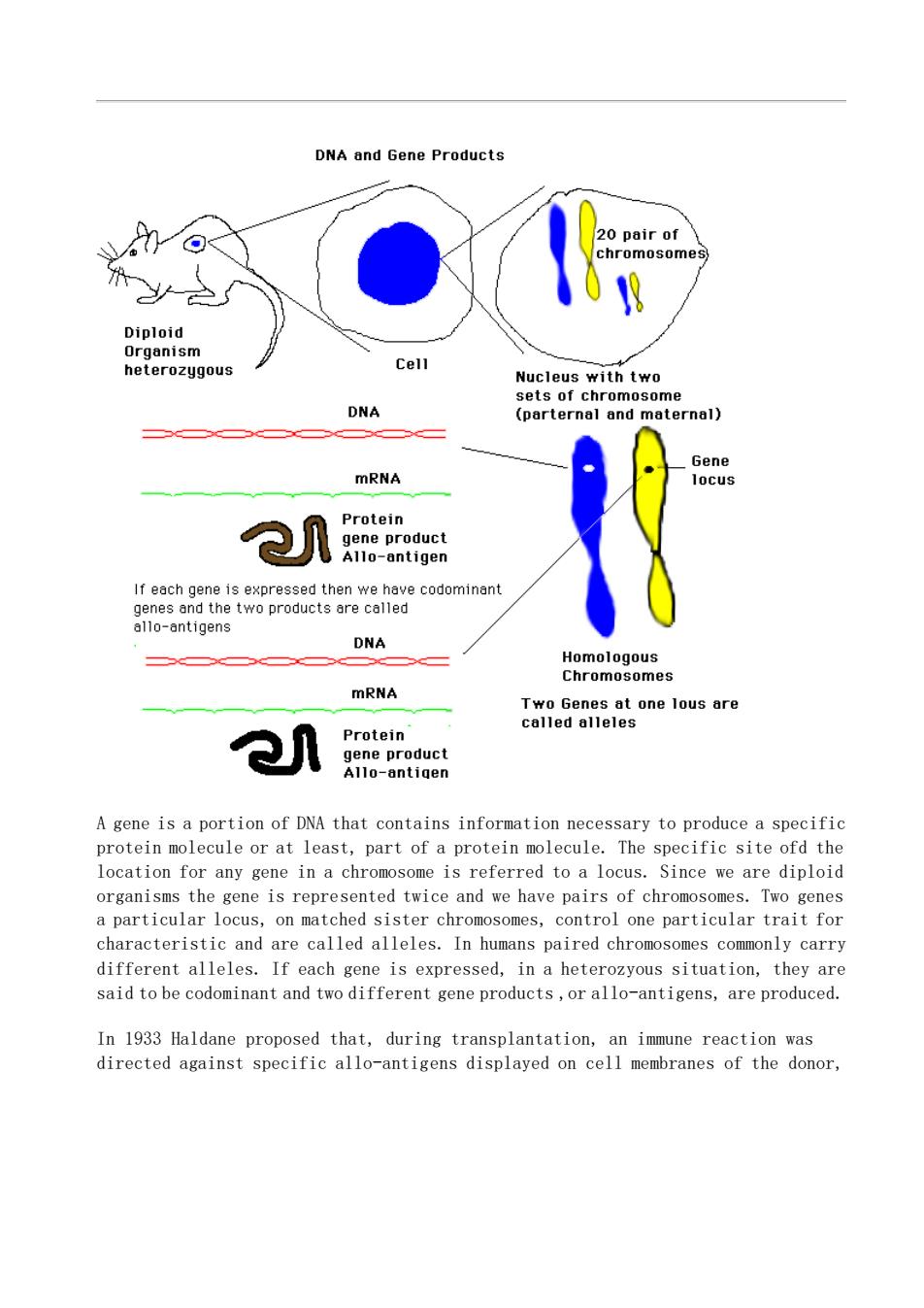
DNA and Gene Products o pair of Diploid hetersm Cell Nucleus with two DNA 8e98rnhr8m0erna mRNA 己八n Protein If each gene is expressed then we have codominant DNA Homologous Chromosomes mRNA Protein e-anusen A gene is a portion of DNA that contains information necessary to produce a specific eation t gnee I referred to a locus. part of a protein molecule.The specific site ofd the Since we are diploid organisms the gene is represented twice and we have pairs of chromosomes.Two genes a particular locus,on matched sister chromosomes,control one particular trait for characteristic and are called alleles.In humans paired chromosomes commonly carry different alleles.If each gene is expressed,in a heterozyous situation,they are said tobe codominant and are produced In 1933 Haldane proposed that,during transplantation,an immune reaction was directed against specific allo-antigens displayed on cell membranes of the donor
A gene is a portion of DNA that contains information necessary to produce a specific protein molecule or at least, part of a protein molecule. The specific site ofd the location for any gene in a chromosome is referred to a locus. Since we are diploid organisms the gene is represented twice and we have pairs of chromosomes. Two genes a particular locus, on matched sister chromosomes, control one particular trait for characteristic and are called alleles. In humans paired chromosomes commonly carry different alleles. If each gene is expressed, in a heterozyous situation, they are said to be codominant and two different gene products ,or allo-antigens, are produced. In 1933 Haldane proposed that, during transplantation, an immune reaction was directed against specific allo-antigens displayed on cell membranes of the donor
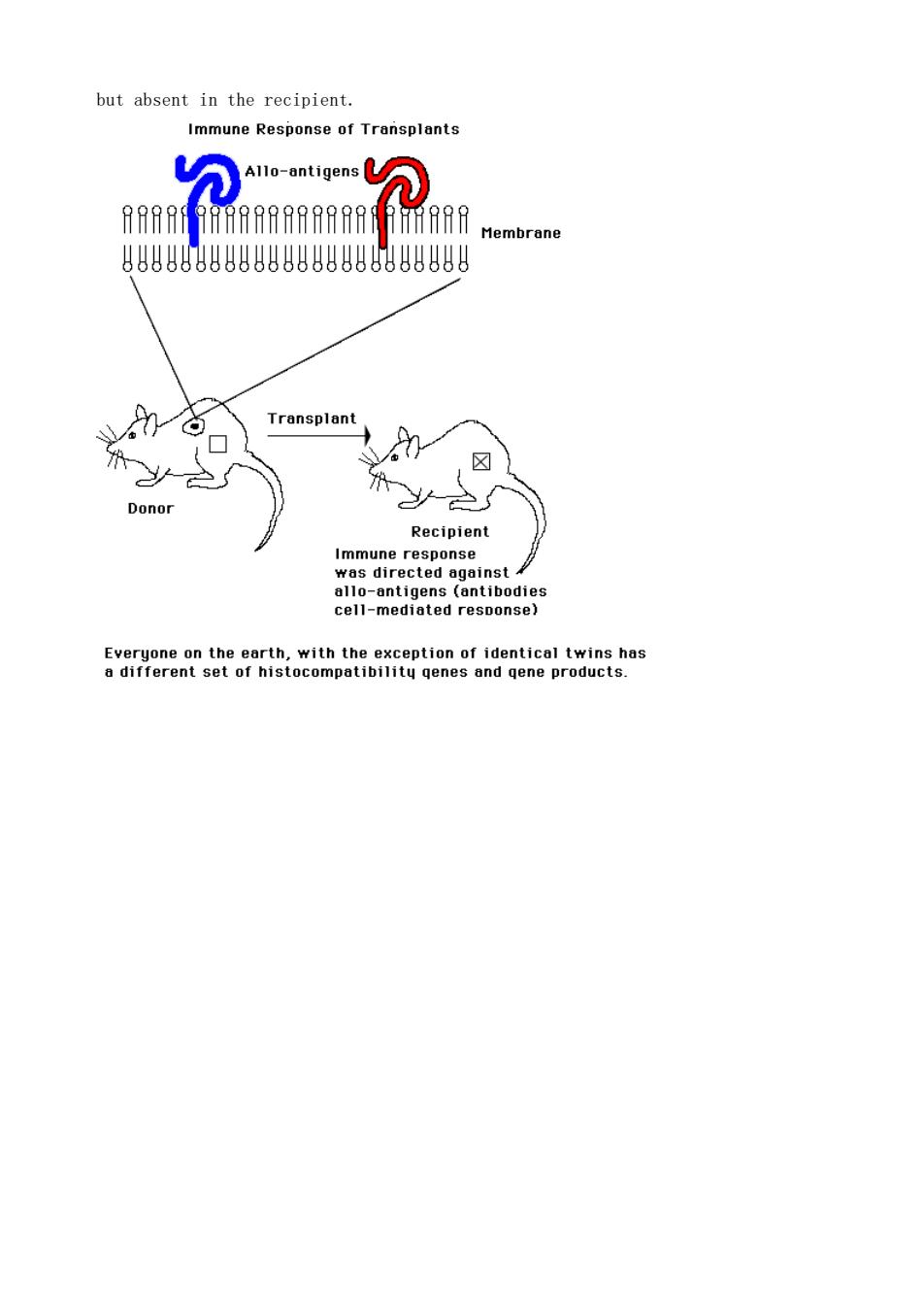
but absent in the recipient. Immune Response of Transplants HAAALHAAAHAAAAAHALAAAHAA Transplant ◇ ☒ Donor Recipient Immune response alo-antigens (antibodies cell-mediated response)
but absent in the recipient
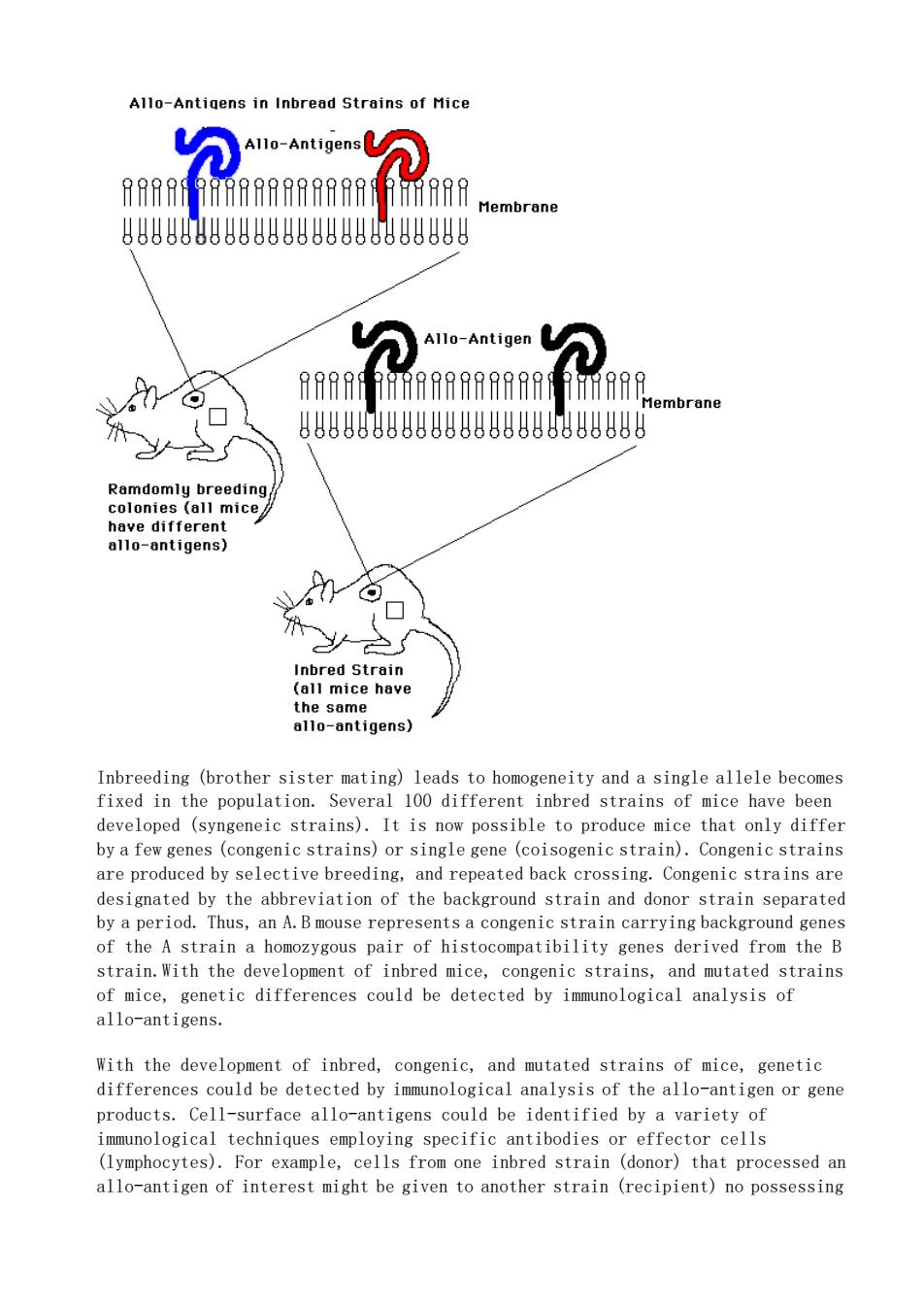
Allo-Antigens in Inbread Strains of Mice Al10-Antigens 888888888888888888888888 Allo-Antigen embrane 88886888888888888688888 Ramdomly breeding colonies(all mice allo-ontigens) Inbreeding (brother sister mating)leads to homogeneity and a single allele becomes fixed in the population.Several 100 different inbred strains of mice have been developed (syn are produced by selective breeding,and repeated back crossing.Congenic strains are designated by the abbreviation of the background strain and donor strain separated by a period.Thus,an A.B mouse represents a congenic strain carrying background genes of the A strain a homozygous pair of histocompatibility genes derived from the B strain.With the dev lopment of inbred mice,congenic strains. and mutated strains of mice,genetic differences could be detected by immunological analysis of allo-antigens. With the development of inbred,congenic,and mutated strains of mice,genetic differences could be detected by immunological analysis of the allo-antigen or gene products.Cell-surface allo-antigens could be identified by a variety of techniques employing specific antibodiesor effector ce (lymphocytes).For example,cells from one inbred strain (donor)that processed an allo-antigen of interest might be given to another strain (recipient)no possessing
Inbreeding (brother sister mating) leads to homogeneity and a single allele becomes fixed in the population. Several 100 different inbred strains of mice have been developed (syngeneic strains). It is now possible to produce mice that only differ by a few genes (congenic strains) or single gene (coisogenic strain). Congenic strains are produced by selective breeding, and repeated back crossing. Congenic strains are designated by the abbreviation of the background strain and donor strain separated by a period. Thus, an A.B mouse represents a congenic strain carrying background genes of the A strain a homozygous pair of histocompatibility genes derived from the B strain.With the development of inbred mice, congenic strains, and mutated strains of mice, genetic differences could be detected by immunological analysis of allo-antigens. With the development of inbred, congenic, and mutated strains of mice, genetic differences could be detected by immunological analysis of the allo-antigen or gene products. Cell-surface allo-antigens could be identified by a variety of immunological techniques employing specific antibodies or effector cells (lymphocytes). For example, cells from one inbred strain (donor) that processed an allo-antigen of interest might be given to another strain (recipient) no possessing
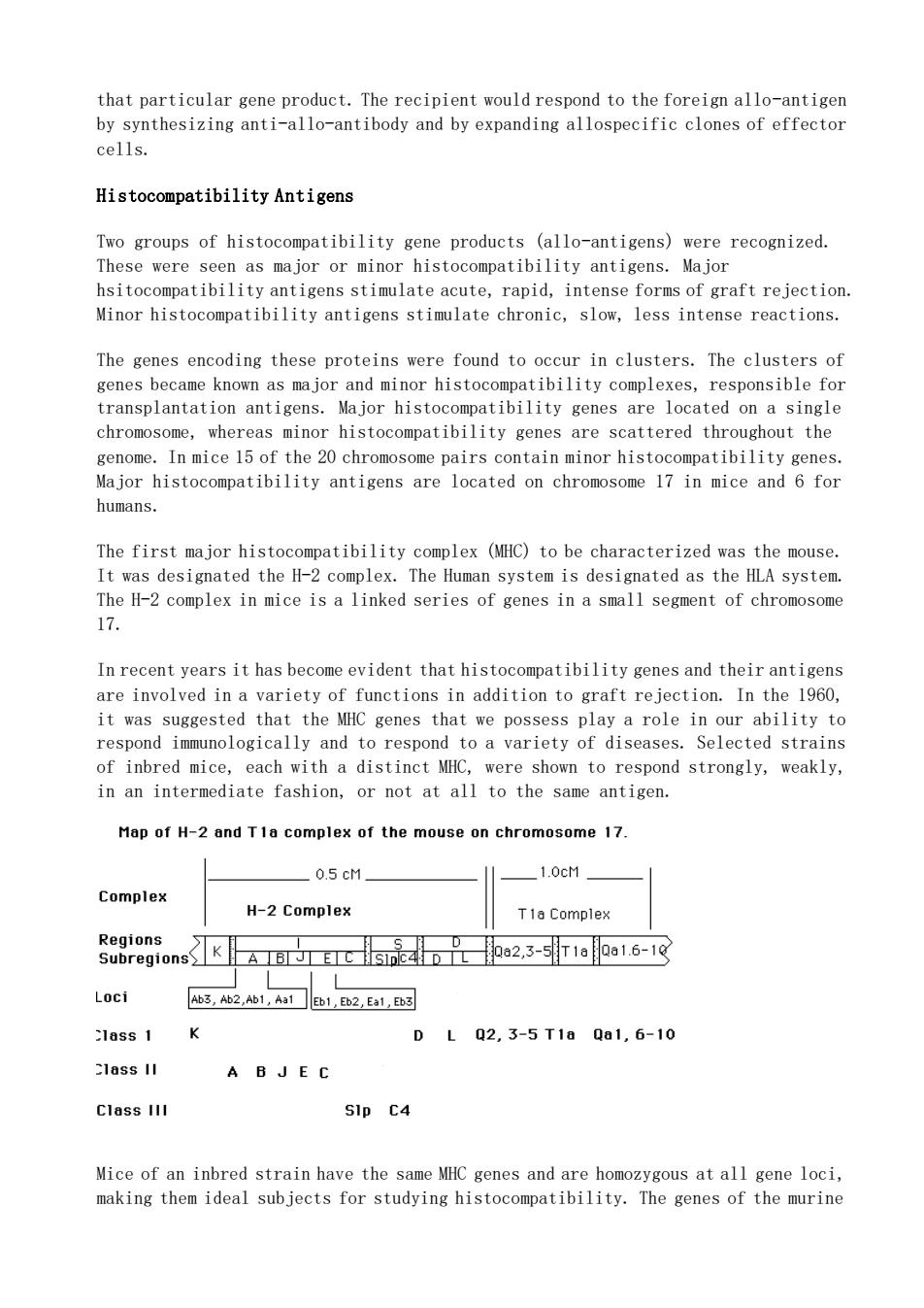
that particular gene product.The recipient would respond to the foreign allo-antigen by synthesizing anti-allo-antibody and by expanding allospecific clones of effector cells. Histocompatibility Antigens Two groups of histocompatibility gene products (allo-antigens)were recognized. These were seen as major or minor histocompatibility antigens.Major hsitocompatibility antigens stimulate acute,rapid,intense forms of graft rejection. Minor histocompatibility antigens stimulate chronic,slow,less intense reactions. encoding these proteins were found to occur in clusters.The clusters of asplantation antigens.jor histocompatibility genes are located on a ecam atibility complexes,responsible fo chromosome,whereas minor histocompatibility genes are scattered throughout the genome.In mice 15 of the 20 chromosome pairs contain minor histocompatibility genes. Major histocompatibility antigens are located on chromosome 17 in mice and 6 for humans The first major histocompatibility complex (MC)to be characterized was the mouse It was designated the H-2 complex.The Human system is designated as the HLA system The h-2 complex in mice is a linked series of genes in a small segment of chromosome 17. In recent years it has become evident that histocompatibility genes and their antigens are involved in a variety of functions in addition to graft rejection.In the 1960 it was suggested that the MHC genes that we possess play a role in our ability to respond immunologically and to respond to a variety of diseases.Selected strains of inbred mice,each with a distinct MHC,were shown to respond strongly,weakly, in an intermediate fashion,or not at all to the same antigen. Map of H-2 and T1a complex of the mouse on chromosome 17. 0.5cM Complex H-2 Complex Tia Complex Loci Ab3,A62,Ab1,As1☐E®1,Eb2,E61,Eb3 class 1 K DL02.3-5T1aQa1,6-10 class I Class Ill SIp C4 Mice of an inbred strain have the same MHC genes and are homozygous at all gene loci, making them ideal subjects for studying histocompatibility.The genes of the murine
that particular gene product. The recipient would respond to the foreign allo-antigen by synthesizing anti-allo-antibody and by expanding allospecific clones of effector cells. Histocompatibility Antigens Two groups of histocompatibility gene products (allo-antigens) were recognized. These were seen as major or minor histocompatibility antigens. Major hsitocompatibility antigens stimulate acute, rapid, intense forms of graft rejection. Minor histocompatibility antigens stimulate chronic, slow, less intense reactions. The genes encoding these proteins were found to occur in clusters. The clusters of genes became known as major and minor histocompatibility complexes, responsible for transplantation antigens. Major histocompatibility genes are located on a single chromosome, whereas minor histocompatibility genes are scattered throughout the genome. In mice 15 of the 20 chromosome pairs contain minor histocompatibility genes. Major histocompatibility antigens are located on chromosome 17 in mice and 6 for humans. The first major histocompatibility complex (MHC) to be characterized was the mouse. It was designated the H-2 complex. The Human system is designated as the HLA system. The H-2 complex in mice is a linked series of genes in a small segment of chromosome 17. In recent years it has become evident that histocompatibility genes and their antigens are involved in a variety of functions in addition to graft rejection. In the 1960, it was suggested that the MHC genes that we possess play a role in our ability to respond immunologically and to respond to a variety of diseases. Selected strains of inbred mice, each with a distinct MHC, were shown to respond strongly, weakly, in an intermediate fashion, or not at all to the same antigen. Mice of an inbred strain have the same MHC genes and are homozygous at all gene loci, making them ideal subjects for studying histocompatibility. The genes of the murine
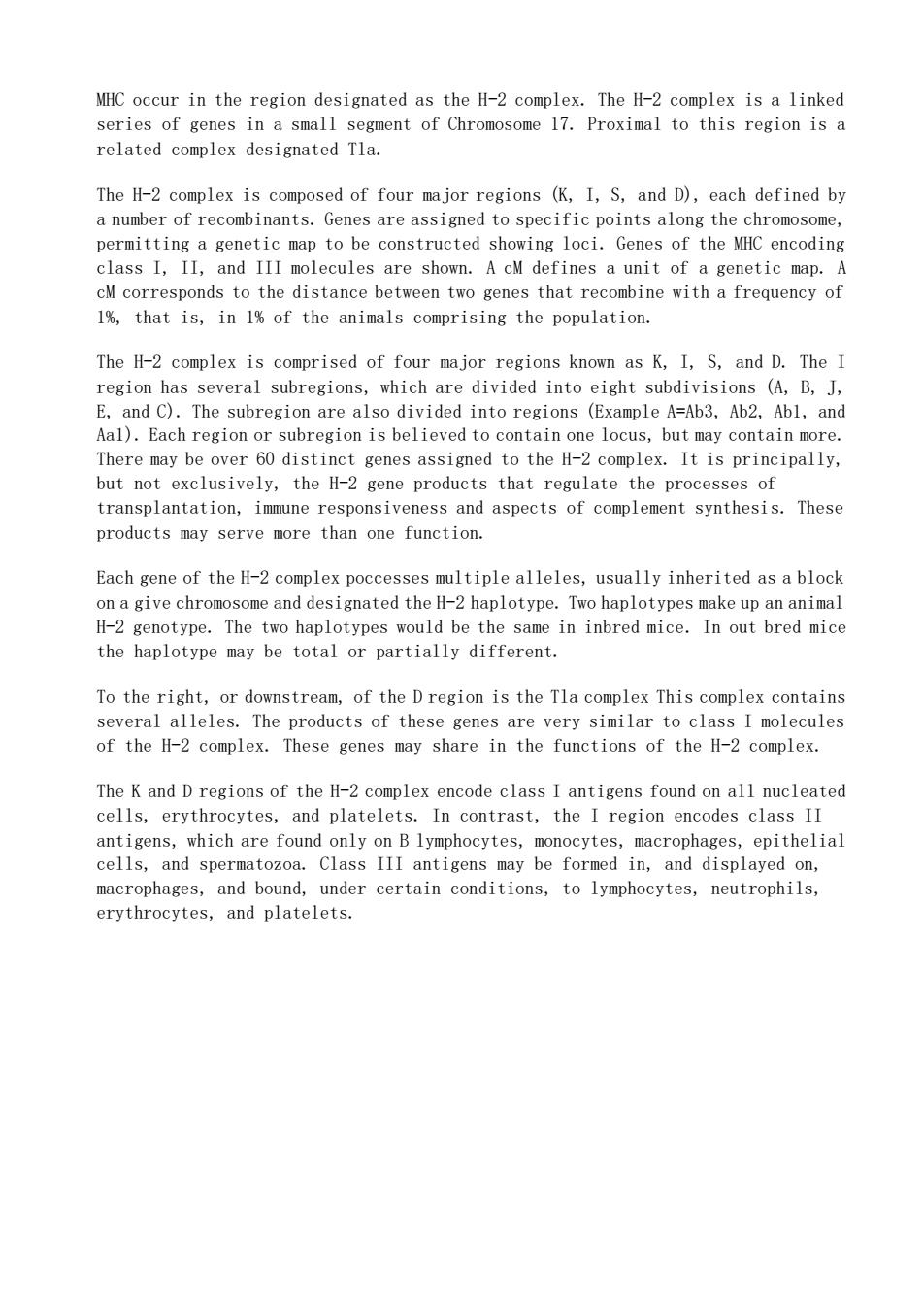
MHC occur in the region designated as the H-2 complex.The H-2 complex is a linked series of genes in a small segment of Chromosome 17.Proximal to this region is a related complex designated Tla The H-2 complex is composed of four major regions (K,I,S,and D),each defined by a number of recombinants.Genes are assigned to specific points along the chromosome, permitting a genetic map to be constructed showing loci.Genes of the MHC encoding class I,II,and III molecules are shown.A cM defines a unit of a genetic map.A cM corresponds to the distance between two genes that recombine with a frequency of 1%,that is,in 1%of the animals comprising the population. The H-2 complex is comprised of four major regions known as K,I,S,and D.The I region has several subregions,which are divided into eight subdivisions (A,B,J, E,and C).The subregion are also divided into regions (Example A=Ab3,Ab2,Abl,and Aal).Each region or subregion is believed to contain one locus,but may contain more. There may be over 60 distinct genes assigned to the H-2 complex.It is principally but not exclusively,the H-2 gene products s that regulate the processes of transplantation,immune responsiveness and aspects of complement synthesis.These products may serve more than one function. Each gene of the H-2 complex poccesses multiple alleles,usually inherited as a block on a give chromosome and designated the H-2 haplotype.Two haplotypes make up an animal H-2 genotype.The two haplotypes would be the same in inbred mice.In out bred mic the haplotype may be total or partially different. To the right,or downstream,of the D region is the Tla complex This complex contains several alleles.The products of these genes are very similar to class I molecules of the H-2 complex.These genes may share in the functions of the H-2 complex. The K and D regions of the H-2 complex encode class I antigens found on all nucleated cells,erythrocytes,and platelets.In contrast,the I region encodes class II antigens,which are found only on B lymphocytes,monocytes,macrophages,epithelial cells,and spermatozoa.Class III antigens may be formed in,and displayed on, macrophages,and bound,under certain conditions,to lymphocytes,neutrophils, erythrocvtes.and platelets
MHC occur in the region designated as the H-2 complex. The H-2 complex is a linked series of genes in a small segment of Chromosome 17. Proximal to this region is a related complex designated Tla. The H-2 complex is composed of four major regions (K, I, S, and D), each defined by a number of recombinants. Genes are assigned to specific points along the chromosome, permitting a genetic map to be constructed showing loci. Genes of the MHC encoding class I, II, and III molecules are shown. A cM defines a unit of a genetic map. A cM corresponds to the distance between two genes that recombine with a frequency of 1%, that is, in 1% of the animals comprising the population. The H-2 complex is comprised of four major regions known as K, I, S, and D. The I region has several subregions, which are divided into eight subdivisions (A, B, J, E, and C). The subregion are also divided into regions (Example A=Ab3, Ab2, Ab1, and Aa1). Each region or subregion is believed to contain one locus, but may contain more. There may be over 60 distinct genes assigned to the H-2 complex. It is principally, but not exclusively, the H-2 gene products that regulate the processes of transplantation, immune responsiveness and aspects of complement synthesis. These products may serve more than one function. Each gene of the H-2 complex poccesses multiple alleles, usually inherited as a block on a give chromosome and designated the H-2 haplotype. Two haplotypes make up an animal H-2 genotype. The two haplotypes would be the same in inbred mice. In out bred mice the haplotype may be total or partially different. To the right, or downstream, of the D region is the Tla complex This complex contains several alleles. The products of these genes are very similar to class I molecules of the H-2 complex. These genes may share in the functions of the H-2 complex. The K and D regions of the H-2 complex encode class I antigens found on all nucleated cells, erythrocytes, and platelets. In contrast, the I region encodes class II antigens, which are found only on B lymphocytes, monocytes, macrophages, epithelial cells, and spermatozoa. Class III antigens may be formed in, and displayed on, macrophages, and bound, under certain conditions, to lymphocytes, neutrophils, erythrocytes, and platelets

Epitopes nyd 8988R9899898 8g88888888 H-2 public and private specificities 翻A K Ag DAg 口W K Ag D Ag Cell/tissue typing of HLA class I Ags with MAb Mononuclear cells Collect Add cell to wells HLA class I Ags Incubate Complement Add vital dye Dye excluded cell live Dye not excluded

Most membrane-surface antigens which are exposed to the surface of a cell display a number of epitopes or antigenic determinants.Allo-antigens possess unique epitopes peculiar to their haplotype(private specificities)but they my share epitopeswith antigen of other haplotypes (public specificities) Each haplotype of an inbred strain produces antigens which can stimulate an immune response in strains possessing a haplotype lacking that antigen or unique epitopes within that antigen.This can be exploited as a diagnostic or analytical tool. Monoclonal antibodies for a single epitope can be produced.A panel of different onclon antibodies can be developed that permits serological tissue typing.The antibodies can be used to identify a wide range of class I MHC determinants.Class II antigens can be detected by measuring their ability to stimulate allogeneic lymphocyte to divide in a mixed lymphocyte culture. Typing of HLA cigmphocyte Mononuclear Sti cells cells lator Collect Collect Coculture Add H-thimidine Incubate recognized as foreign cognized as foreign no increas in H-thymidine H-thymidine in DNA DNA increased
Most membrane-surface antigens which are exposed to the surface of a cell display a number of epitopes or antigenic determinants. Allo-antigens possess unique epitopes peculiar to their haplotype (private specificities), but they may share epitopes with antigen of other haplotypes (public specificities). Each haplotype of an inbred strain produces antigens which can stimulate an immune response in strains possessing a haplotype lacking that antigen or unique epitopes within that antigen. This can be exploited as a diagnostic or analytical tool. Monoclonal antibodies for a single epitope can be produced. A panel of different monoclonal antibodies can be developed that permits serological tissue typing. These antibodies can be used to identify a wide range of class I MHC determinants. Class II antigens can be detected by measuring their ability to stimulate allogeneic lymphocyte to divide in a mixed lymphocyte culture
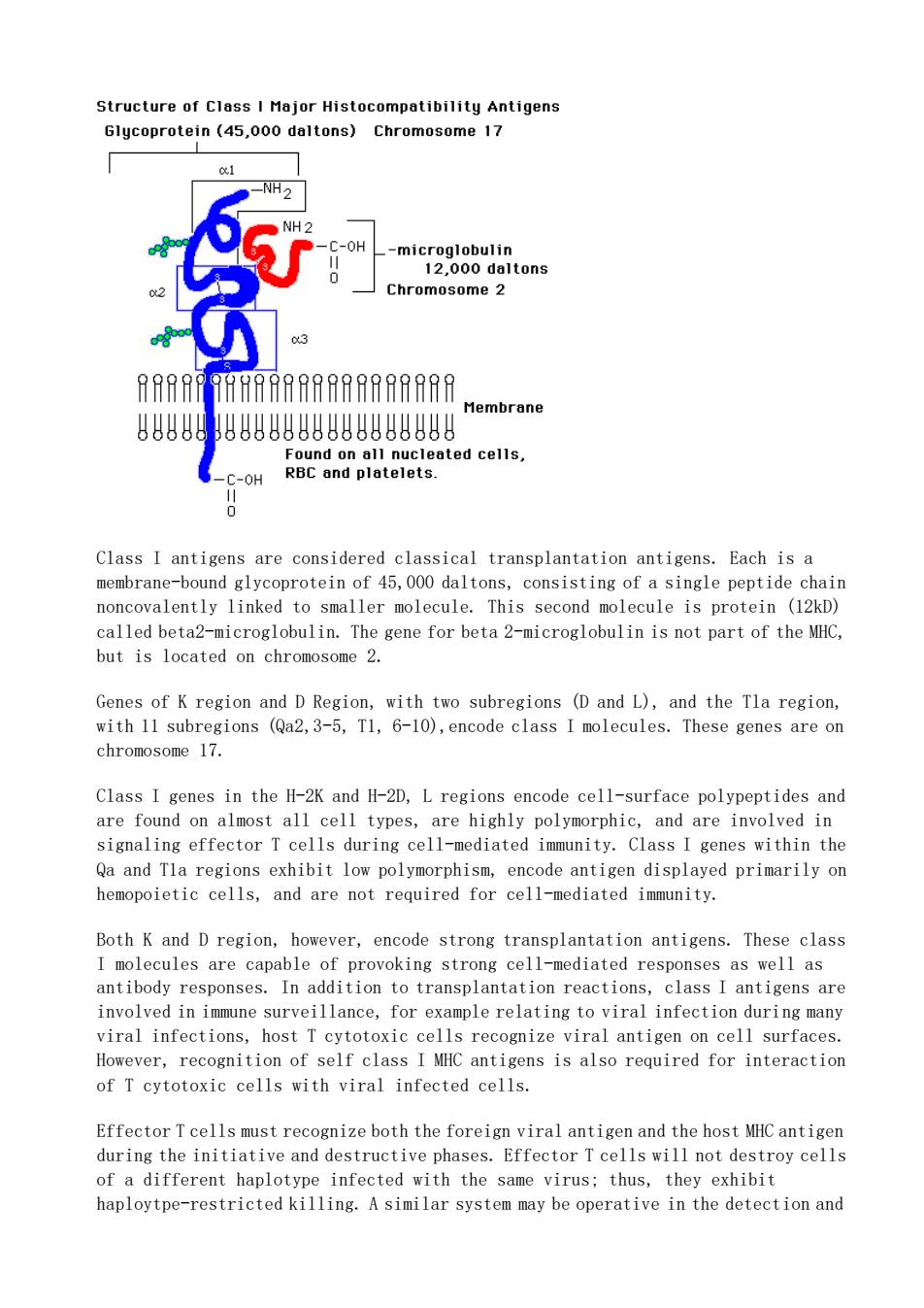
Structure of Closs I Mojor Histocompatibility Antigen Glycoprotein (45,000 daitons)Chromosome 17 1 -micrg2a8intoans Chromosome 2 8999e99H99999999999999 Membrane AAABAA8A88AAA88A -OH 8c2dngpnl86lg6ateacels, Class I antigens are considered classical transplantation antigens.Each is a membrane -bound gly consisting of a single peptide chain noncovalently linked to smaller molecule.This second molecule is protein (12kD called beta2-microglobulin.The gene for beta 2-microglobulin is not part of the MHC, but is located on chromosome 2. Genes of K region and D Region,with two subregions (D and L),and the Tla region, with 11 subregions (Qa2,3-5,T1,6-10),encode class I molecules.These genes are on chromosome 17. Class I genes in the H-2K and H-2D,L regions encode cell-surface polypeptides and are found on almost all cell types,are highly polymorphic,and are involved in signaling effector T cells during cell-mediated immunity.Class I genes within the Qa and Tla regions exhibit low polymorphism,encode antigen displayed primarily on hemopoietic ells and are no required for cell-me diated immu nity Both K and D region,however,encode strong transplantation antigens.These class I molecules are capable of provoking strong cell-mediated responses as well as antibody responses.In addition to transplantation reactions,class I antigens are involved in immune surveillance,for example relating to viral infection during many viral infections,host T cytotoxic cells recognize viral antigen on cell surfaces However, recognition of self class antigens is also required for interaction of T cytotoxic cells with viral infected cells. Effector T cells must recognize both the foreign viral antigen and the host MHC antigen during the initiative and destructive phases.Effector T cells will not destroy cells of a different haplotype infected with the same virus:thus,they exhibit haploytpe-restricted killing.A similar system may be operative in the detection and
Class I antigens are considered classical transplantation antigens. Each is a membrane-bound glycoprotein of 45,000 daltons, consisting of a single peptide chain noncovalently linked to smaller molecule. This second molecule is protein (12kD) called beta2-microglobulin. The gene for beta 2-microglobulin is not part of the MHC, but is located on chromosome 2. Genes of K region and D Region, with two subregions (D and L), and the Tla region, with 11 subregions (Qa2,3-5, T1, 6-10),encode class I molecules. These genes are on chromosome 17. Class I genes in the H-2K and H-2D, L regions encode cell-surface polypeptides and are found on almost all cell types, are highly polymorphic, and are involved in signaling effector T cells during cell-mediated immunity. Class I genes within the Qa and T1a regions exhibit low polymorphism, encode antigen displayed primarily on hemopoietic cells, and are not required for cell-mediated immunity. Both K and D region, however, encode strong transplantation antigens. These class I molecules are capable of provoking strong cell-mediated responses as well as antibody responses. In addition to transplantation reactions, class I antigens are involved in immune surveillance, for example relating to viral infection during many viral infections, host T cytotoxic cells recognize viral antigen on cell surfaces. However, recognition of self class I MHC antigens is also required for interaction of T cytotoxic cells with viral infected cells. Effector T cells must recognize both the foreign viral antigen and the host MHC antigen during the initiative and destructive phases. Effector T cells will not destroy cells of a different haplotype infected with the same virus; thus, they exhibit haploytpe-restricted killing. A similar system may be operative in the detection and

elimination of transformed cells that must display self-MHC antigens to be destroyed by effector T cells.This requirement that both the foreign antigen and the host MHC antigen be present is known as MHC restriction. Structure of Class Il Antigens 20 tom B peptide chain 28,000 daltons Carbohydrate mor rcrophages epithe R99999999898R998998 BBB88888888888888g 0 Class II antigens are glycoproteins co onsisting of two n covalently linked alpha and beta peptide chains with molecular weights of 32 and 28 kD.respectively Each chain contains two extracellular domains,a connecting peptide,a tansmembrane region,and a cytoplasmic tail.The I region is divided into five subregions (A,B,J,E,and C) with eight alleles encoding class II antigens arranged on chromosome 17.These antigens are involved in a number of immunological events. Antigen-presenting cells(APC)display I region antigen(Ia),in a restricted manner analogous to MHC restriction.The T helper cell and B cells or T cytotoxic cells and between T suppressor cells and other T cells.Delayed-type hypesensitivity is also controlled in large measure by I region gene products.Thus class II molecules are concerned with recruitment of T helper,T suppressor,and T delayed hypersensitivitit cells.Many genes of the I region and their subregions and subdivisions dramatically influence our ability to mount an immune response to an antigen.Consequently,they are referred to as immune response (Ir)genes
elimination of transformed cells that must display self-MHC antigens to be destroyed by effector T cells. This requirement that both the foreign antigen and the host MHC antigen be present is known as MHC restriction. Class II antigens are glycoproteins consisting of two noncovalently linked alpha and beta peptide chains with molecular weights of 32 and 28 kD, respectively Each chain contains two extracellular domains, a connecting peptide, a tansmembrane region, and a cytoplasmic tail. The I region is divided into five subregions (A,B, J, E, and C) with eight alleles encoding class II antigens arranged on chromosome 17. These antigens are involved in a number of immunological events. Antigen-presenting cells (APC) display I region antigen (Ia), in a restricted manner, analogous to MHC restriction. The T helper cell and B cells or T cytotoxic cells and between T suppressor cells and other T cells. Delayed-type hypesensitivity is also controlled in large measure by I region gene products. Thus class II molecules are concerned with recruitment of T helper, T suppressor, and T delayed hypersensitivitit cells. Many genes of the I region and their subregions and subdivisions dramatically influence our ability to mount an immune response to an antigen. Consequently, they are referred to as immune response (Ir) genes